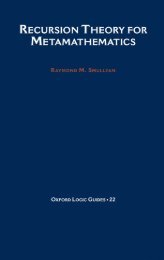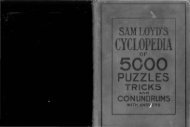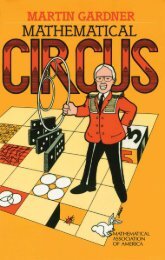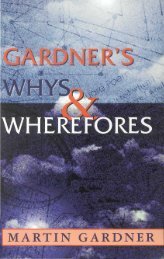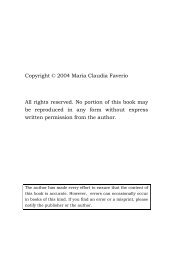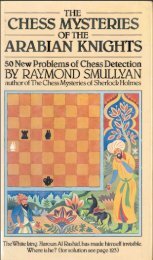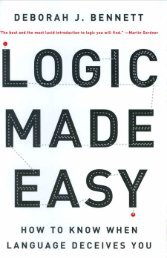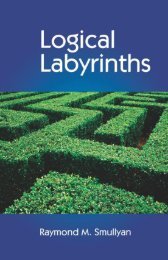Which Alice?
Which Alice?
Which Alice?
Create successful ePaper yourself
Turn your PDF publications into a flip-book with our unique Google optimized e-Paper software.
Solutions to the Puzzles<br />
ANOTHER CASE There are eight possible cases for what A,<br />
B, C could have said. There are two possibilities for what A said,<br />
and with each of these two possibilities there are two possibilities for<br />
B; thus there are four possibilities for what A, B said. (These<br />
possibilities are [1] A, B both claimed to be guilty; [2] A said he was<br />
guilty; B said he was innocent; [3] A said he was innocent; B said he<br />
was guilty; [4] A, B both claimed to be innocent.) Now, with each of<br />
these four possibilities for A and B, there are two possibilities for<br />
what C said, so there are eight possibilities altogether for what A, B,<br />
C said.<br />
With each of these eight possible cases for what the defendants<br />
said, there are three possibilities for which of the three defendants<br />
was actually guilty. Therefore, there are twenty-four possibilities for<br />
the whole business (the whole business being what each defendant<br />
said together with which one was actually guilty). If we knew which<br />
of these twenty-four possibilities held, we would of course know<br />
which one lied and which ones told the truth. We will now make a<br />
systematic table for each of these twenty-four possibilities. This<br />
table will be used not only for this puzzle but for a later one as well.<br />
Explanations immediately follow the table.<br />
The L's and T's indicate who was lying and who was telling the<br />
truth (L stands for lying and T for truth-telling). For example, in Case<br />
5B (which we find in Group 5 under the B column) we see that A<br />
was lying, B was lying, and C was telling the truth. (Case 5B means,<br />
of course, the case in which A said he was guilty, B said he was<br />
innocent, and C said A was innocent, and B was actually guilty.)<br />
More examples: In Case 8C, all three were lying; in Case 3B, all<br />
three were telling the truth; in Case 4C, A was telling the truth and<br />
B, C were both lying.<br />
Now, the Jabberwocky, after being told what each defendant said,<br />
and also that there was at least one true statement and at least one<br />
false statement, knew who was guilty. What could the Jabberwocky<br />
have been told to have enabled him to know? Suppose he were told<br />
that A claimed innocence, B claimed innocence, and C claimed A<br />
was innocent (this takes us within the three possibilities of Case 1).<br />
The Jabberwocky could then have ruled out that C was guilty<br />
177




